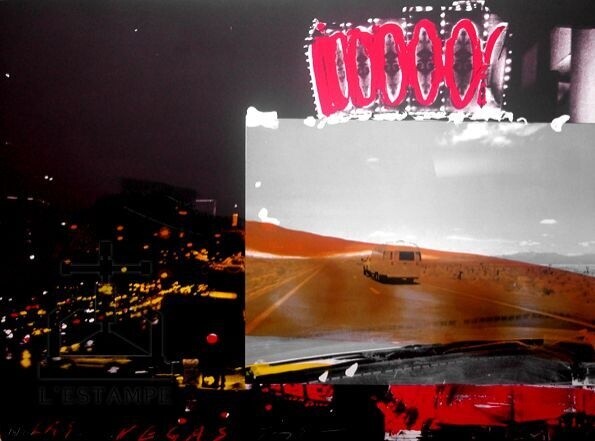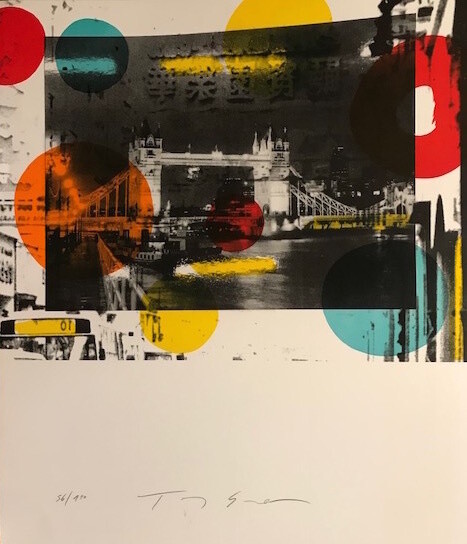Tony Soulié is a French multidisciplinary artist renowned for his work in painting, printmaking, sculpture, installation art, and photography. He gained prominence in the Nouvelle Abstraction movement during the 1970s and 1980s, and his work has been exhibited worldwide, with pieces housed in major public and private collections such as the Museum of Modern Art in Paris and the Utsunomiya Museum of Art.
Biography
Tony Soulié (born 1955) is a French artist known for his work in painting, printmaking, sculpture, installation art, and photography. Soulié was a significant figure in the "Nouvelle Abstraction" (Neo Post Pictorialism) movement in France during the 1970s and 1980s. His work has been showcased in numerous exhibitions around the world and is featured in prestigious public and private collections, including the Museum of Modern Art in Paris, the Utsunomiya Museum of Art, and the Hawaii State Foundation on Culture and the Arts, among others.
His art has been displayed in esteemed venues such as the Museo Nacional de Bellas Artes in Chile, the Musée des Tapisseries in Aix-en-Provence, the Honolulu Museum of Art Spalding House, the Museum of Avallon, the Kulturhuset Art-Center in Stockholm, the Clayarch Gimhae Museum in South Korea, the Industry Museum in Charleroi, the Museum of Modern Art in Rio de Janeiro, the Museum for Fine Arts in Brasilia, the Colombian National Museum in Bogota, the Museum of Contemporary Art in Zagreb, and the Royal Post Museum in Bangkok. His works are also part of collections in many of these museums and private foundations, and he is represented by art galleries in cities such as London, Paris, Frankfurt, Copenhagen, Seoul, Tokyo, and Santa Fe, New Mexico.
Raised in Paris, France, Soulié was born in the Bastille/Marais neighborhood, an area traditionally known for its furniture craft industry. He studied at the École des Arts Appliqués and, while primarily recognized as a painter, he has also created artist's books, sculptures, prints, installations, and performances.
Between 1982 and 1991, Soulié participated in a series of theatrical productions, performing on stage. He later took on scenography for various productions and created several land art installations, particularly on volcanoes, including those inside active calderas. Although his family has roots in the Albi region of southern France, Soulié grew up in Paris. His first solo gallery show was held at Gallery Durgnat in Switzerland in 1977. In 1984, he gained significant attention through his participation in the Grand Palais exhibition "Peintures, l’autre nouvelle génération," which introduced a new wave of French artists. This exhibition led to regular shows, including his association with the Françoise Palluel Gallery, which began at the 1985 Foire Internationale d'Art Contemporain (FIAC) Art Fair and continued until 1996, when the Dhalgren Gallery was launched with a Soulié exhibition.
In 1987, Soulié received the "Villa-Medicis hors les murs" grant from the French Academy in Rome, allowing him to settle in Naples, where he began working on installations and land art projects on volcanoes, starting with Vesuvius. In 1990, he designed a spinnaker for a well-known boat in the Whitbread Round the World Race (now the Volvo Ocean Race), which narrowly avoided sinking after colliding with a whale in the Tasman Sea.
In 1992, Soulié was one of the artists representing France at the Universal Exposition of Seville, Expo '92, in Spain. In 1997, he continued his land art installations on volcanoes in Hawaii, with works on Big Island and Maui. These projects were part of a photographic exhibition held that same year at The Contemporary Museum in Honolulu. Soulié also began working with Galerie Protée, which remains one of his main representations in Paris.
In 1996, Soulié started traveling along the African coasts, creating photopaintings from Zanzibar, Benin, and other locations. These works paralleled his projects on Murano Island in Venice, Italy, where he collaborated with glassmakers to create sculptures based on African fetish figures. The project sought to counter the history of the slave trade, where captives were bought with glass pearls made in Murano. In 1998, he held his first solo exhibition in Japan at the MMG Gallery.
After publishing numerous books and catalogues, the first monograph on Tony Soulié was released in 1999, followed by regular publications, including a 2009 volume documenting his work from 1976 to 2008. Reflecting his Albi origins, Soulié explored the theme of tauromachia, or the magic of bullfighting, first presented in the Faena series of works in 2000.
In 2001, Soulié released "Lagos La Tropicale," a series of photopaintings created in Nigeria, accompanied by text from Dominique Sigaud, portraying the megacity of Lagos. This work, like his project in Havana, proved controversial, leading to cancellations of planned exhibitions by local authorities. Similar works from Benin and São Tomé have been exhibited in various shows.
In 2003, the Museum Convent of the Cordeliers in Châteauroux hosted the first major retrospective of his work, and in 2004, Soulié was awarded the Chevalier de l’Ordre des Arts et des Lettres by the French Ministry of Culture. The Palais Synodal in Sens held a significant exhibition in 2007, titled Panorama, offering a comprehensive review of Soulié's body of work. In 2010, Soulié returned to creating glass sculptures, exploring the sculptural language of the Zuni in a series of works, followed by a 2011 exhibition titled ANIMA-ANIMISME at the Domaine Dalmeran, examining shamanistic relationships with the animus.
Most recently, in 2012, Soulié was invited by the town and region of La Rochelle to exhibit in multiple venues throughout the area during the summer.
Style, Movement, and Subjects
Tony Soulié's art is often associated with the postmodern movement, characterized by its use of mixed media and abstract expressionism. His distinctive style merges photography with painting, collage, and installations. Common subjects in Soulié's work include natural landscapes, urban settings, and the relationship between the two. His use of bold colors, dynamic compositions, and the depiction of movement highlights his fascination with the ever-changing world around him.
The materials Tony Soulié uses in his paintings have remained consistent over the years. Varnish, carborundum powder mixed with acrylic paint have been his signature elements since 1992, starting with his first series of painted photographs from Africa. These materials, which are not traditionally intended for fine arts, were adopted from his immediate environment when his studio was in the Bastille neighborhood of Paris, an area known at the time for its artisan workshops involved in furniture assembly.
The inclusion of carborundum in his artwork has a connection to his volcano installations, as the silicon component of this synthetic compound is naturally found in volcanic exhalations as pure crystals.
Soulié's technique of "photo-paintings," as he calls them, involves large-scale black and white photographs taken during his travels around the world, which he overlays with ink, acrylic, varnish, and carborundum. The subjects explored in these painted photographs include megalopolises, captured from his own photography in the world's largest cities, as well as flowers and dream catchers.
In addition to his paintings, Soulié has produced numerous artist's books and collaborative portfolios with poets and other artists such as Michel Butor, Patricia Erbelding, Serge Gavronsky, Patrick Grainville, Alain Jouffroy, Michel Luneau, J. M. G. Le Clézio, Tita Reut, and Salah Stétié.
Famous Pieces
Some of Tony Soulié's most famous artworks include his "Urban Landscapes" series, which showcases the energy and complexity of city life through a combination of painting and photography. Another notable collection is the "Volcanoes" series, where Soulié explores the raw power and beauty of nature through abstract interpretations of volcanic environments. Additionally, his "Traces" series is highly regarded for its exploration of time, memory, and the transient nature of human existence.
 las-vegas Printmaking by Tony Soulié
las-vegas Printmaking by Tony Soulié
Analysis of some creations
Tony Soulié's original lithograph titled "Las Vegas," signed and numbered (79/120), is a powerful example of his ability to merge photography, painting, and printmaking into a cohesive visual narrative. The piece juxtaposes a desolate desert road scene with the vibrant, chaotic energy of Las Vegas, represented through a palette of dark tones, punctuated by bright reds and yellows. The central image of a vehicle on an empty road evokes a sense of solitude and isolation, contrasting sharply with the electrifying urban imagery that surrounds it.
The use of red scribbles and abstract forms over the photograph adds a dynamic layer of tension, symbolizing perhaps the frenetic pace and artificiality of Las Vegas. The dark, almost noirish quality of the cityscape is counterbalanced by the stark brightness of the desert scene, creating a dialogue between natural emptiness and human-made excess.
This lithograph encapsulates Soulié's exploration of contrasting environments and the impact of human culture on the landscape, making it a compelling piece that invites viewers to reflect on the dualities of modern life. The work is not just a depiction of a place but an evocative commentary on the collision between nature and urbanization, solitude and spectacle.
 London (2015) Printmaking by Tony Soulié
London (2015) Printmaking by Tony Soulié
Tony Soulié's original lithograph titled "London," signed and numbered (56/120), is a striking piece that encapsulates his unique approach to printmaking, blending photographic elements with abstract overlays. The artwork presents a nocturnal view of the iconic Tower Bridge, set against the backdrop of London's bustling urban landscape. This central image is rendered in monochrome, evoking a sense of timelessness and grandeur.
What sets this piece apart is the use of vibrant, translucent circles in hues of red, yellow, blue, and black, scattered across the composition. These abstract shapes contrast sharply with the detailed photographic image of the bridge, adding a layer of modernity and dynamism to the scene. The colorful circles seem to float over the cityscape, creating a sense of movement and energy that reflects the ever-changing nature of London.
The lithograph also incorporates subtle references to the city's multicultural aspect, hinted at by the faint text in the background, possibly alluding to London's diverse cultural influence. The juxtaposition of the historic landmark with contemporary abstract elements highlights Soulié's ability to blend the old with the new, the real with the abstract.
Printed on BFK Rives 400 gr paper, "London" not only captures the essence of a city known for its rich history and vibrant culture but also transforms it into a modern, almost dreamlike vision. Soulié’s work invites viewers to see London not just as a physical place but as a living, breathing entity full of color, history, and endless possibilities.
Exhibitions and the Art Market
Tony Soulié's artworks have been exhibited in prestigious venues worldwide, including locations in Japan and the United States. His work is recognized in the art market, particularly among collectors who appreciate his innovative use of mixed media and his exploration of themes related to nature and urban life. While his works are valued, they are not consistently among the highest-priced at auctions, but they maintain a strong presence and appeal within the contemporary art community.
Artists Inspired by Tony Soulié
Tony Soulié has inspired contemporary artists, particularly those interested in blending photography, painting, and mixed media. His work captures the essence of places and the transient nature of human experiences, influencing artists who seek to push the boundaries of traditional art forms. Additionally, Soulié has collaborated with various poets and writers, such as Michel Butor and J.M.G. Le Clézio, creating artist’s books that merge visual art with literary expression.
Tony Soulié is a versatile and influential artist whose work seamlessly blends photography, painting, and mixed media to explore themes of nature, urban life, and human existence. His contributions to contemporary art, characterized by a unique postmodern style, have earned him international acclaim. With a rich legacy of exhibitions, a strong presence in the art market, and a lasting impact on future generations of artists, Tony Soulié remains a key figure in the history of modern art.


 Selena Mattei
Selena Mattei